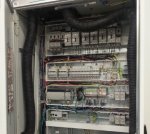acerfootball
Member
- Location
- Madison, WI, US
My company is reviewing our Electrical Safety policy and a question regarding the operation of breakers came up. Attached is a picture of the breakers in question(480V, 50A and 70A breakers, Cat. II per 2012 70E). My understanding of 70E(2015) is that "Normal Operation" of equipment shall be permitted when "(3) The equipment doors are closed and secured.". In the picture, clearly I can't operate the breakers with the doors closed so does this mean that the breakers can only be operated when they are de-energized? Meaning I shut down the upstream device, open the door to this panel, close the breaker, close the door, and then turn on the upstream device? If so, the argument was made that circuit breakers' lifespan would be hit if this process became the norm for operating the breakers. I'm not sure I agree with that but I'm 6 months on the job so still learning.
What are you thoughts operating these breakers while following 70E?
What are you thoughts operating these breakers while following 70E?

